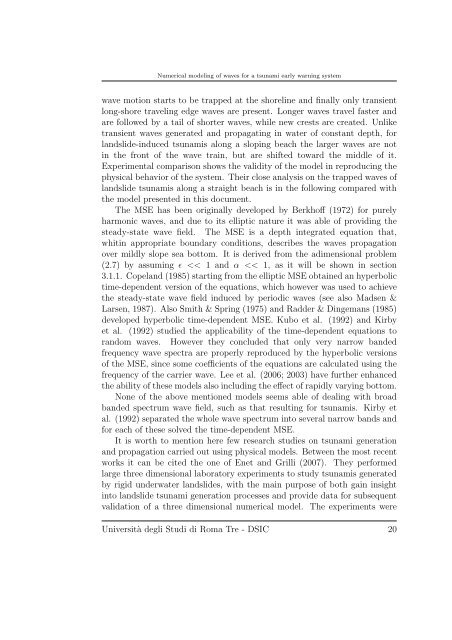Numerical modeling of waves for a tsunami early warning system
Numerical modeling of waves for a tsunami early warning system
Numerical modeling of waves for a tsunami early warning system
Create successful ePaper yourself
Turn your PDF publications into a flip-book with our unique Google optimized e-Paper software.
<strong>Numerical</strong> <strong>modeling</strong> <strong>of</strong> <strong>waves</strong> <strong>for</strong> a <strong>tsunami</strong> <strong>early</strong> <strong>warning</strong> <strong>system</strong><br />
wave motion starts to be trapped at the shoreline and finally only transient<br />
long-shore traveling edge <strong>waves</strong> are present. Longer <strong>waves</strong> travel faster and<br />
are followed by a tail <strong>of</strong> shorter <strong>waves</strong>, while new crests are created. Unlike<br />
transient <strong>waves</strong> generated and propagating in water <strong>of</strong> constant depth, <strong>for</strong><br />
landslide-induced <strong>tsunami</strong>s along a sloping beach the larger <strong>waves</strong> are not<br />
in the front <strong>of</strong> the wave train, but are shifted toward the middle <strong>of</strong> it.<br />
Experimental comparison shows the validity <strong>of</strong> the model in reproducing the<br />
physical behavior <strong>of</strong> the <strong>system</strong>. Their close analysis on the trapped <strong>waves</strong> <strong>of</strong><br />
landslide <strong>tsunami</strong>s along a straight beach is in the following compared with<br />
the model presented in this document.<br />
The MSE has been originally developed by Berkh<strong>of</strong>f (1972) <strong>for</strong> purely<br />
harmonic <strong>waves</strong>, and due to its elliptic nature it was able <strong>of</strong> providing the<br />
steady-state wave field. The MSE is a depth integrated equation that,<br />
whitin appropriate boundary conditions, describes the <strong>waves</strong> propagation<br />
over mildly slope sea bottom. It is derived from the adimensional problem<br />
(2.7) by assuming ɛ

















